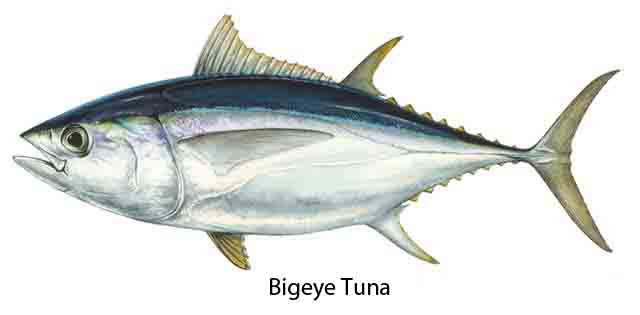
BIGEYE TUNA

Thunnus obesus
Spanish: Atún de Ojo Grande, Atún Patulo
The Bigeye Tuna is characterized by its “tuna-like” body, deep metallic blue back, and white on the lower sides and belly. It has a faint iridescent blue band along its side. Its first dorsal fin is yellow. Its anal and second dorsal fin are pale yellow, and the finlets are bright yellow, edged in black.
The Bigeye Tuna closely resembles and can be easily confused with the Yellowfin Tuna, Thunnus albacares (long anal and second dorsal fins that are yellow, and yellow finlets, with vertical bands of dots on the belly. The livers of Bigeye Tuna are also serrated, whereas the Yellowfin Tuna has a smooth-edged liver.
The Bigeye Tuna is a seasonal oceanic pelagic schooling species that is found only along the Pacific coast of the Baja California peninsula, along the coast of mainland Mexico, around all oceanic islands. It is notably absent from the Sea of Cortez.
Bigeye Tuna also inhabit the waters of the western Carribean along the Mexico coast.
The Bigeye Tuna is found at all levels in the water column and encountered either on the surface or up to 1,000 feet deep, which is rare for other tunas.
It is known to dive 822 feet in less than a minute with a water temperature change of 27 degrees, indicative of its ability to make extraordinarily long and deep runs under difficult conditions. It is reported to reach 500 pounds in weight (which are rare with 80 pounders being more common).
The Bigeye Tuna can be caught in fair abundance and is normally located via trolled feathers or jigs, and then the bite is maintained on live anchovies or sardines with ample chum being used to keep the school in residence. It is viewed as prized game fish on the upper half of the Pacific side of Baja, providing great bragging rights and excellent table fare.